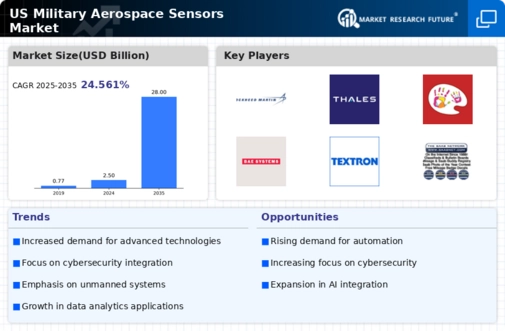The US Military Aerospace Sensors Market is a dynamic and highly competitive sector, reflecting the increasing importance of advanced sensor technology in military applications. This market encompasses a wide range of sensors utilized in aerospace systems, including radar, electro-optical, infrared, and other sensing technologies that are critical for surveillance, target acquisition, navigation, and overall situational awareness. The competitive landscape is characterized by significant investments in research and development, collaboration with government agencies, and a focus on technological innovation.
Companies in this sector aim to enhance operational capabilities and ensure superior defense readiness through the development of advanced sensing solutions that meet the unique demands of military operations.Raytheon Technologies stands as a prominent player in the US Military Aerospace Sensors Market, leveraging its extensive background in defense technology and commitment to innovation. The company possesses a strong portfolio of advanced sensor systems that cater to various military applications, reflecting its technical expertise and market acumen. Raytheon Technologies is distinguished by its focus on integrated solutions that enhance operational efficiency and effectiveness for military clients.
The company has established a robust presence in the market through strategic partnerships with the US government and defense agencies, emphasizing its capability to meet current and emerging security challenges. Moreover, Raytheon Technologies benefits from a solid foundation of intellectual property and a talented workforce, enabling it to maintain a competitive edge in developing cutting-edge sensor technologies.Lockheed Martin is another key player in the US Military Aerospace Sensors Market, recognized for its focus on innovation and high-performance technologies.
The company offers a wide array of sensor solutions that encompass radar, electro-optics, and various intelligence-oriented systems, positioning it strongly within the military aerospace domain. Lockheed Martin's strength lies in its ability to integrate advanced sensors with complex systems, enhancing capabilities for air, land, and naval operations. The company has made significant investments in research and development, ensuring a consistent pipeline of innovative products. Additionally, Lockheed Martin's strategic mergers and acquisitions have augmented its market presence and broadened its technological offerings, allowing it to stay competitive in a rapidly evolving landscape.
With a commitment to addressing the needs of the US military, Lockheed Martin remains a vital contributor to national defense through its sophisticated sensor technologies.












